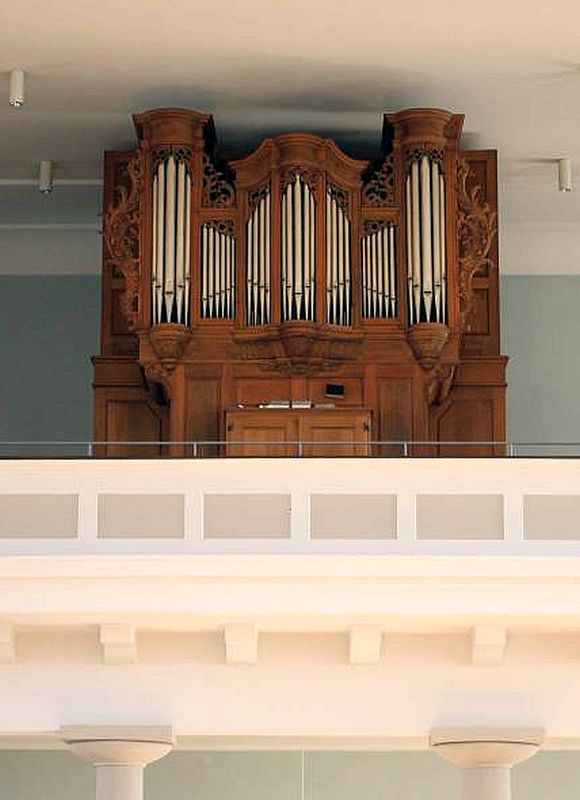Complete description of the selected organ

Photo: Michiel van 't Einde
Heitersheim, Deutschland (Baden-Württemberg) - Katholische Pfarrkirche Sankt Bartholomäus
Municipal: Heitersheim
Region:Baden
Address: Johanniterstraße 74, 79423, Heitersheim
Website: https://seelsorgeeinheit-heitersheim.de/
Description nr.: 2021027.
Built by: Heintz Orgelbau (1981) - opus 53
The organ contains older material: Organ Case from 1787 by Conrad Sauer
Technical data
Specification
Grand Orgue (Expressif) (C-g'''): Bourdon 16', Principal 8', Bourdon 8', Salicional 8' - C-B from Bourdon, Prestant 4', Flûte 4', Quinte 2 2/3', Quarte de Nazard 2', Tierce 1 3/5', Larigot 1 1/3', Fourniture 4 rangs (2'), Cymbale 4 rangs (1'), Trompette 8', Voix Humaine 8', Tremblant.
Positif (C-g'''): Bourdon 8', Prestant 4', Flûte 4', Nazard 2 2/3', Doublette 2', Tierce 1 3/5', Sifflet 1' - from cis''' 1 1/3', Cornet 5 rangs (8') (from c°), Fourniture 4 rangs (2/3'), Crmorne 8', Tremblant.
Pédale (C-f'): Subbass 16' - C-B 1787, Octavbass 8' - partial 1901, Gedeckt 8', Prestant 4', Bombarde 16', Trompette 8', Clairon 4'.
Couplers: Accouplement du Positif au Grand Orgue, Tirasse Grand Orgue, Tirasse Positif.

Photo: Michiel van 't Einde
Heitersheim, Deutschland (Baden-Württemberg) - Katholische Pfarrkirche Sankt Bartholomäus
Municipal: Heitersheim
Region:Baden
Address: Johanniterstraße 74, 79423, Heitersheim
Website: https://seelsorgeeinheit-heitersheim.de/
Description nr.: 2021027.
Built by: Heintz Orgelbau (1981) - opus 53
The organ contains older material: Organ Case from 1787 by Conrad Sauer
| Year | Builder | Opus | Activity | 1787 | Conrad Sauer | 1 | new organ | 1827 | Franz Xaver Bernauer | transfer/relocate | 1861 | Eduard Stadtmüller | modify stoplist | 1901 | Johann Franz Anton Kiene | new organ in old case | 1953 | Willy Dold | modify stoplist | 1981 | Heintz Orgelbau | 53 | new organ in old case | 2018 | Karl Göckel | restoration |
- The first organ by Conrad Sauer was installed in 1787 in the parish church of Heitersheim. It was built in the style of his teacher Johann Andreas Silbermann. After the construction of a new church, the organ was transferred in 1826-1827 by Xaver Bernauer. He didn't change much on the organ. The disposition was altered in 1861 by Eduard Stadtmüller. He replaced the Fagott with a Fugara, and the Trompet with a Gedackt.
- Unfortunately, the old interior of the organ has been lost. In 1901 Anton Kiene built a new pneumatic organ with fifteen stops in the historic organ case. This instrument was modified by Willy Dold in 1953, under the direction of Franz Stemmer.
- In 1981 Georges Heintz built a new mechanical organ in the old organ case. Consultant was Hans Musch. A connection was sought with the work of Conrad Sauer and Johann Andreas Silbermann. The pipes are made after examples from the organ in the abbey church of Ettenheimmünster. The Positif is installed inside the historic organ case. The Grand Orgue is installed in a swell box behind the organ. The only pipes that have been preserved from 1787 are the twelve largest pipes of the Subbass.
- The organ was overhauled by Karl Göckel in 2018. The voicing was revised on this occasion.
Technical data
| Number of stops per division | |
| - Grand Orgue | 14 |
| - Positif | 10 |
| - Pédale | 7 |
| Total number of stops | 31 |
| Key action | Mechanical |
| Stop action | Mechanical |
| Windchest(s) | Slider chests |
Specification
Grand Orgue (Expressif) (C-g'''): Bourdon 16', Principal 8', Bourdon 8', Salicional 8' - C-B from Bourdon, Prestant 4', Flûte 4', Quinte 2 2/3', Quarte de Nazard 2', Tierce 1 3/5', Larigot 1 1/3', Fourniture 4 rangs (2'), Cymbale 4 rangs (1'), Trompette 8', Voix Humaine 8', Tremblant.
Positif (C-g'''): Bourdon 8', Prestant 4', Flûte 4', Nazard 2 2/3', Doublette 2', Tierce 1 3/5', Sifflet 1' - from cis''' 1 1/3', Cornet 5 rangs (8') (from c°), Fourniture 4 rangs (2/3'), Crmorne 8', Tremblant.
Pédale (C-f'): Subbass 16' - C-B 1787, Octavbass 8' - partial 1901, Gedeckt 8', Prestant 4', Bombarde 16', Trompette 8', Clairon 4'.
Couplers: Accouplement du Positif au Grand Orgue, Tirasse Grand Orgue, Tirasse Positif.
| Compound stop | Composition |
| Fourniture 4 rangs (Grand Orgue) | C: 2' - 1 1/3' - 1' - 2/3'. c°: 2 2/3' - 2' - 1 1/3' - 1'. c': 4' - 2 2/3' - 2' - 1 1/3'. c'': 5 1/3' - 4' - 2 2/3' - 2'. c''': 8' - 5 1/3' - 4' - 2 2/3'. |
| Cymbale 4 rangs (Grand Orgue) | C: 1' - 2/3' - 1/2' - 1/3'. c°: 1 1/3' - 1' - 2/3' - 1/2'. c': 2' - 1 1/3' - 1' - 2/3'. c'': 2 2/3' - 2' - 1 1/3' - 1'. c''': 4' - 2 2/3' - 2' - 1 1/3'. |
| Cornet 5 rangs (Positif) | c°: 8' - 4' - 2 2/3' - 2' - 1 3/5'. |
| Fourniture 4 rangs (Positif) | C: 2/3' - 1/2' - 1/3' - 1/4'. f°: 1' - 2/3' - 1/2' - 1/3'. f': 1 1/3' - 1' - 2/3' - 1/2'. f'': 2' - 1 1/3' - 1' - 2/3'. |
| Other specifications | |
|---|---|
| Different specifications |
|
| Literature |
|
 |
 |
 |
 |
 |
